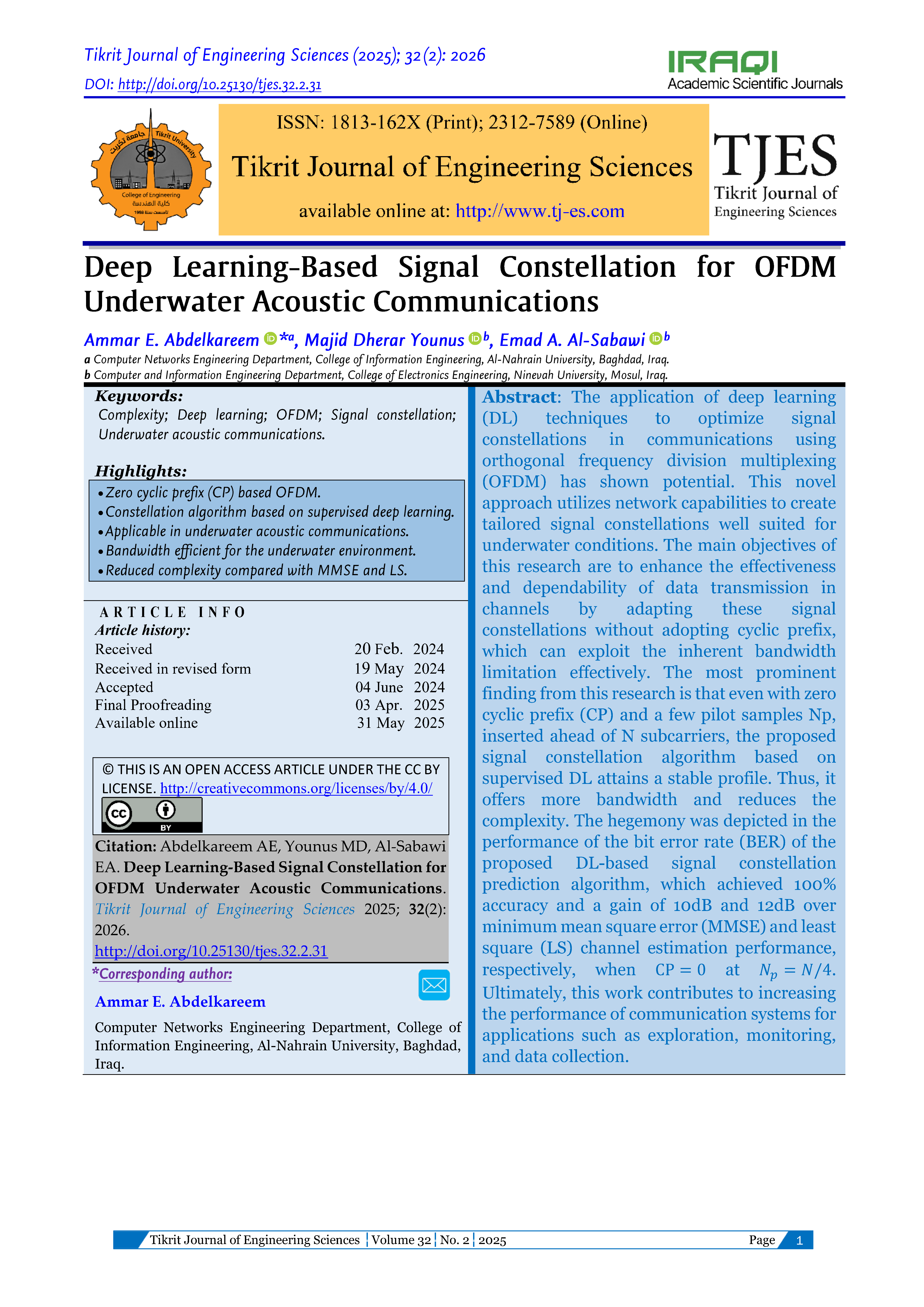Deep Learning-Based Signal Constellation for OFDM Underwater Acoustic Communications
Main Article Content
Abstract
The application of deep learning (DL) techniques to optimize signal constellations in communications using orthogonal frequency division multiplexing (OFDM) has shown potential. This novel approach utilizes network capabilities to create tailored signal constellations well suited for underwater conditions. The main objectives of this research are to enhance the effectiveness and dependability of data transmission in channels by adapting these signal constellations without adopting cyclic prefix, which can exploit the inherent bandwidth limitation effectively. The most prominent finding from this research is that even with zero cyclic prefix (CP) and a few pilot samples Np, inserted ahead of N subcarriers, the proposed signal constellation algorithm based on supervised DL attains a stable profile. Thus, it offers more bandwidth and reduces the complexity. The hegemony was depicted in the performance of the bit error rate (BER) of the proposed DL-based signal constellation prediction algorithm, which achieved 100% accuracy and a gain of 10dB and 12dB over minimum mean square error (MMSE) and least square (LS) channel estimation performance, respectively, when CP=0 at N_p=N/4. Ultimately, this work contributes to increasing the performance of communication systems for applications such as exploration, monitoring, and data collection.
Article Details
Section

This work is licensed under a Creative Commons Attribution 4.0 International License.
THIS IS AN OPEN ACCESS ARTICLE UNDER THE CC BY LICENSE http://creativecommons.org/licenses/by/4.0/
References
Kumar A, Srinivas KK, Majhi S. Automatic Modulation Classification for Adaptive OFDM Systems Using Convolutional Neural Networks with Residual Learning. IEEE Access 2023; 11:61013-61024.
An Z, Zhang T, Shen M, De Carvalho E, Ma B, Yi C, Song T. Series-Constellation Feature Based Blind Modulation Recognition for Beyond 5G MIMO-OFDM Systems with Channel Fading. IEEE Transactions on Cognitive Communications and Networking 2022; 8(2):793-811.
Zhang Y, Li C, Wang H, Wang J, Yang F, Meriaudeau F. Deep Learning Aided OFDM Receiver for Underwater Acoustic Communications. Applied Acoustics 2022; 187:108515.
Qin Z, Ye H, Li GY, Juang BH. Deep Learning in Physical Layer Communications. IEEE Wireless Communications 2019; 26(2):93-99.
Jebur BA, Alkassar SH, Abdullah MA, Tsimenidis CC. Efficient Machine Learning-Enhanced Channel Estimation for OFDM Systems. IEEE Access 2021; 9:100839-100850.
Zhang J, He H, Wen CK, Jin S, Li GY. Deep Learning Based on Orthogonal Approximate Message Passing for CP-Free OFDM. 2019 IEEE International Conference on Acoustics, Speech and Signal Processing (ICASSP) 2019:8414-8418.
Dossa RF, Huang S, Ontañón S, Matsubara T. An Empirical Investigation of Early Stopping Optimizations in Proximal Policy Optimization. IEEE Access 2021; 9:117981-117992.
Dos Santos Sousa H, Soares JA, Mayer KS, Arantes DS. CVNN-Based Channel Estimation and Equalization in OFDM Systems Without Cyclic Prefix. XLI Brazilian Symposium on Telecommunications and Signal Processing 2023.
Mohammed AS, Taman AI, Hassan AM, Zekry A. Deep Learning Channel Estimation for OFDM 5G Systems with Different Channel Models. Wireless Personal Communications 2023; 128(4):2891-2912.
Ye H, Li GY, Juang BH. Power of Deep Learning for Channel Estimation and Signal Detection in OFDM Systems. IEEE Wireless Communications Letters 2018; 7(1):114-117.
Liu H, Zhang Y, Zhang X, El-Hajjar M, Yang LL. Deep Learning Assisted Adaptive Index Modulation for MmWave Communications with Channel Estimation. IEEE Transactions on Vehicular Technology 2022; 71(9):9186-9201.
Zhang Q, Guo H, Liang YC, Yuan X. Constellation Learning-Based Signal Detection for Ambient Backscatter Communication Systems. IEEE Journal on Selected Areas in Communications 2019; 37(2):452-463.
Peng S, Jiang H, Wang H, Alwageed H, Zhou Y, Sebdani MM, Yao YD. Modulation Classification Based on Signal Constellation Diagrams and Deep Learning. IEEE Transactions on Neural Networks and Learning Systems 2019; 30(3):718-727.
Hong S, Zhang Y, Wang Y, Gu H, Gui G, Sari H. Deep Learning-Based Signal Modulation Identification in OFDM Systems. IEEE Access 2019; 7:114631-114638.
Abdelkareem AE, Sharif BS, Tsimenidis CC. Adaptive Time Varying Doppler Shift Compensation Algorithm for OFDM-Based Underwater Acoustic Communication Systems. Ad Hoc Networks 2016; 45:104-119.
Bai Q, Wang J, Zhang Y, Song J. Deep Learning-Based Channel Estimation Algorithm over Time Selective Fading Channels. IEEE Transactions on Cognitive Communications and Networking 2019; 6(1):125-134.
Awad SD, Sali A, Al-Wani MM, Al-Saegh AM, Mandeep JS, Raja Abdullah RS. End-to-End DVB-S2X System Design with DL-Based Channel Estimation Over Satellite Fading Channels at Ka-Band. Computer Networks 2023; 236:110022.
Shuxia G, Yang S, Ying G, Qianjin H. Low Complexity Minimum Mean Square Error Channel Estimation for Adaptive Coding and Modulation Systems. China Communications 2014; 11(1):126-137.
Zhang A, Lipton ZC, Li M, Smola AJ. Dive into Deep Learning. Cambridge: Cambridge University Press; 2023.
Hochreiter S, Schmidhuber J. Long Short-Term Memory. Neural Computation 1997; 9(8):1735-1780.





